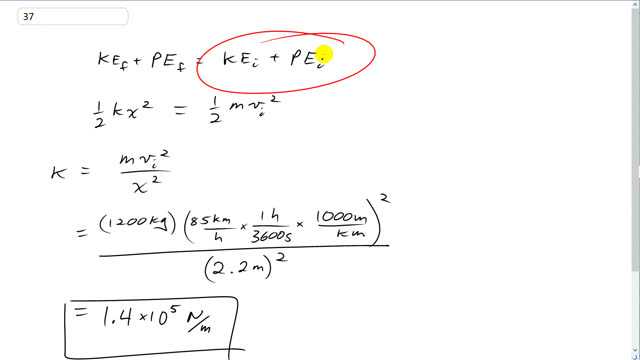
A 1200-kg car moving on a horizontal surface has speed when it strikes a horizontal coiled spring and is brought to rest in a distance of 2.2 m. What is the spring stiffness constant of the spring?

In order to watch this solution you need to have a subscription.
This is Giancoli Answers with Mr. Dychko. The total of final energy, after the car has compressed a spring, equals the total initial energy. And initially, there's only kinetic because there is no gravitational potential energy to care about because it's all on the same level; it's not changing height at all; and there's no potential energy either because the spring is not yet compressed. And after the car is finished compressing the spring, there's no kinetic energy so that term is 0. And all the energy will have turned into elastic potential energy. So we have one-half times the spring constant times the amount the spring is compressed, relative to it's equilibrium position, squared equals one-half mass of the car times its initial velocity squared. And the one-halfs cancel and we can divide both sides by x squared and we get spring constant is mass times initial velocity squared over compression of the spring squared. So that's 1200 kilograms times the speed of the car, converted into meters per second, by dividing by 3.6 or you can look at this way and say, times by 1 hour for every 3600 seconds then times by 1000 meters for every kilometer and square that answer and you get, divide by 2.2 meters squared, and you get 1.4 times 10 to the 5 newtons per meter is the spring constant.
Hi, how do you distinguish whether to use KEf + PEf = KEi + PEi on a spring question like this, rather than using Wext = DeltaPE in a question like #35?
Thank you
Hi jmarra_villanova,
Thanks for the question. The formula is a law, which means it's always valid. This is an algebraic way of saying energy is conserved after a movement of some kind. As a law, it could also be used in #35 instead of . Doing so would have looked like this: , where the zero's are substituting for kinetic energy, of which there's none since in #35 the block isn't moving (or the movement is so slow as to be negligible), and is the amount the spring was stretched. Using is just a convenience since it reduces a couple of algebra steps. When in doubt, use conservation of energy.
Hope that helps,
Mr. Dychko